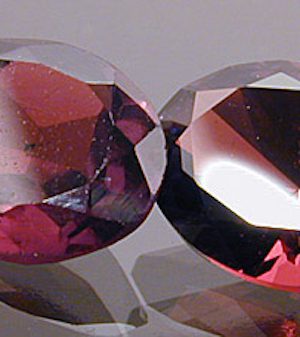Why Custom Gem Cutting Makes a Difference
How does commercial cutting stack up to custom gem cutting? Compare these two similar rhodolite garnets in four key ways and see the difference.
2 Minute Read
One unfair advantage remained. The commercial-cut stone was a bit more included. It now resides in my fish tank. 🙂
Let's see how commercial cutting compares to custom gem cutting in four key areas.
Optical Performance
Look at the photo at the start of the article. Notice that light reflects and sparkles in the stone on the right. On the left, you see a large, lighter colored area in the middle of the stone. Since the commercial-cut stone was cut at the wrong angles, light will just pass through this area. This effect, known as windowing or a "fish eye," will make the stone appear dead inside.
The stone on the right sparkles because the light can't escape through the bottom of the stone. Light bounces around inside, then back up through the top, often in different colors due to refraction. (Notice the little blue spots).
Polish
Look at the polish on the surfaces of these stones. The one on the right is highly polished. This greatly benefits the gem's brilliance. The stone on the left probably never received a good polish. Most likely, it was thrown in a bucket or bag with other garnets. After repeated handling, it was probably microscopically scratched and pitted. Even if this stone started out almost flawless, it would now look included or dirty upon close inspection. Another thing, watch for "striations" or parallel lines/streaks when looking at a stone's polish. These are actually gouges on the stone's surface.
Meets
Both the first photo and the one below demonstrate bad meetpoints. In other words, you can see where facets should touch each other but don't. Look at the closer edge of the table on the commercial stone. You'll see a facet, a line, then a facet. Those facets should touch each other.
Cutting for Weight?
Oddly enough, the stone on the left was actually cut for weight. The right stone wasn't. In the photo above, the arrow points to the culet (the point on the bottom of the stone). Since it was cut on too shallow an angle, this created the windowing you can see in the first photo. To achieve the proper optical angle, this stone should have been cut smaller.
The other way to cut a stone for weight is to have the entire pavilion (bottom) of the stone "belly cut," the extreme opposite of the commercial stone shown here. Sadly, commercial cutters often cut a really deep stone, then make that last set of crucial culet facets too shallow. As a result, they still cut a window, even though they had plenty of material with which to work. Also, they'll cut the crown (top of the stone) super shallow. Commercial cutters do this so they can make a bigger belly in the pavilion and, thus, yield a heavier stone.
A Picture is Worth a Thousand Words
This last photo demonstrates, again, the difference between good and bad polishing. What is that saying? A picture is worth a thousand words!
What can you say about the commercial-cut stone? "Yep, it's a 6 mm x 8 mm faceted rhodolite garnet oval."
Commercial cutting and custom gem cutting is all the same, right?
Related Articles
Sliver: Faceting Design Diagram
Have One: Faceting Design Diagram
Dishonest People and Hidden Agendas
Crown Star: Faceting Design Diagram
Latest Articles
800 Years of Mogok: A Celebration in Tenuous Times
What is the Average Gemstone Faceting Yield?
Pyroxmangite Value, Price, and Jewelry Information
How to Identify Emerald Simulants and Synthetics
Never Stop Learning
When you join the IGS community, you get trusted diamond & gemstone information when you need it.
Get Gemology Insights
Get started with the International Gem Society’s free guide to gemstone identification. Join our weekly newsletter & get a free copy of the Gem ID Checklist!
